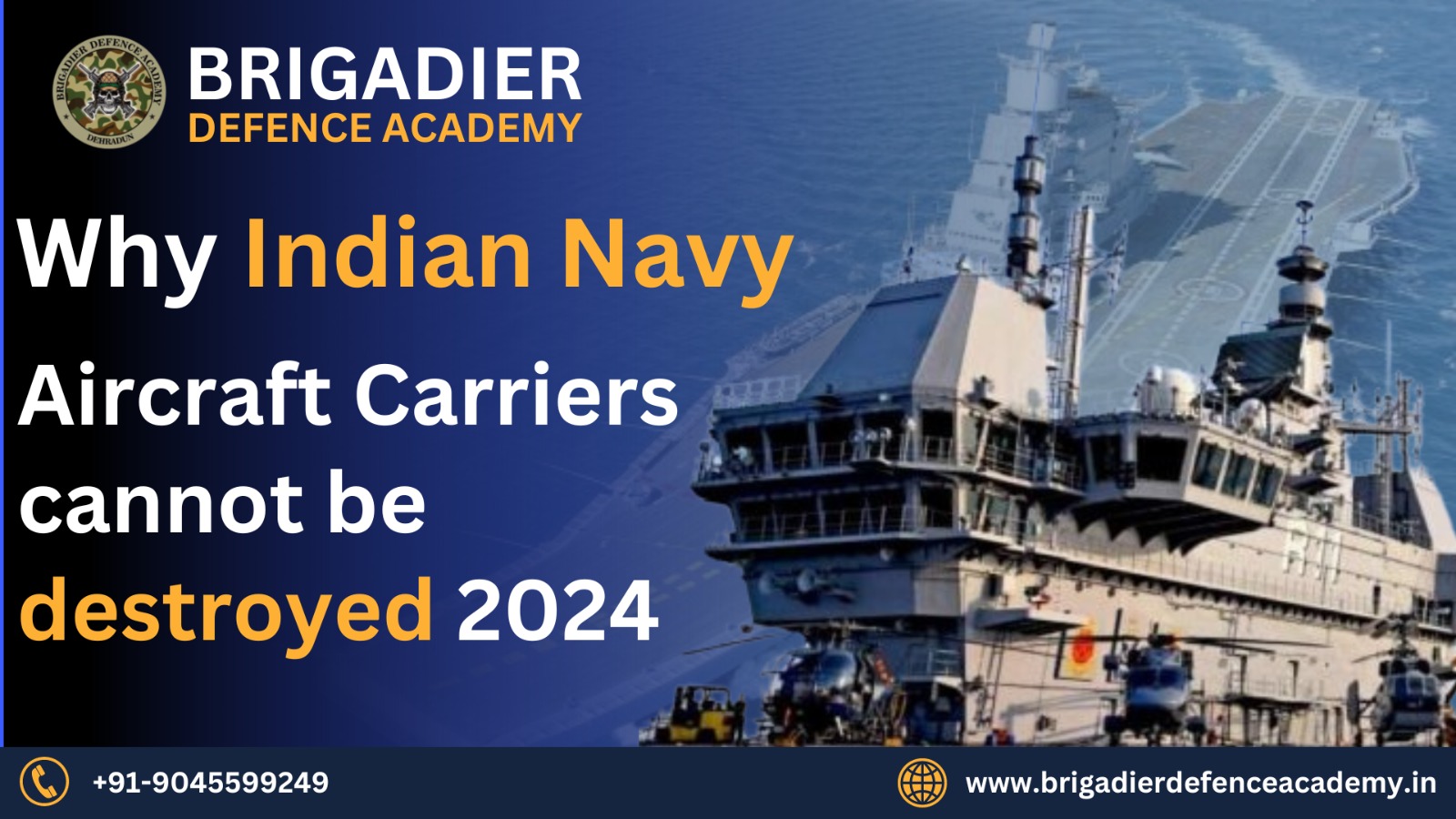- Posted on
- Manya
- No Comments
Introduction:
In the realm of modern naval warfare, Indian Navy Aircraft carriers stand as the ultimate symbols of power projection and strategic dominance. The Indian Navy, with its robust fleet and strategic outlook, has invested significantly in aircraft carriers to bolster its maritime capabilities. However, the question arises: why do Indian Navy aircraft carriers seem invulnerable, almost unbreakable, in the face of potential threats? In this comprehensive analysis, we delve into the key factors that contribute to the resilience and defensive prowess of Indian Navy aircraft carriers, highlighting their strategic importance in the geopolitical landscape of the 21st century.
Historical Context and Evolution:
To understand the present capabilities of Indian Navy aircraft carriers, it’s crucial to trace their historical evolution. The Indian Navy’s carrier journey began with the acquisition of INS Vikrant in the 1960s, marking a significant milestone in indigenous naval development. Over the decades, India has progressed from conventional carrier operations to advanced, nuclear-powered carriers like INS Vikramaditya and the indigenous INS Vikrant (IAC-1), soon to be joined by the INS Vishal.
Naval Power Projection and Strategic Significance:
Indian Navy aircraft carriers serve as force multipliers, extending the reach of maritime forces far beyond coastal waters. They play a pivotal role in power projection, naval diplomacy, humanitarian assistance, and disaster relief operations. The ability to deploy a potent mix of fighter aircraft, helicopters, and support assets from a floating airbase enhances India’s deterrence capabilities and strategic flexibility in both peacetime and conflict scenarios.
Technological Advancements and Defensive Capabilities:
The modern Indian Navy aircraft carriers are fortified with state-of-the-art technologies and defensive systems that significantly reduce their vulnerability to various threats. Advanced radar systems, missile defense shields, electronic warfare suites, and integrated command and control systems ensure comprehensive situational awareness and swift response capabilities. Moreover, the incorporation of indigenous technologies and collaborations with global defense partners has further strengthened the carriers’ defensive posture.
Aircraft Complement and Operational Readiness:
The effectiveness of aircraft carriers hinges on their complement of combat aircraft, maritime patrol aircraft, and rotary-wing assets. The Indian Navy’s carrier-based aircraft, including MiG-29K fighters, maritime reconnaissance aircraft, and anti-submarine warfare helicopters, are meticulously maintained and continuously upgraded to meet evolving threats. Additionally, rigorous training programs and joint exercises with allied navies enhance operational readiness and interoperability, bolstering the overall combat effectiveness of carrier strike groups.
Geopolitical Dynamics and Maritime Security Challenges:
In the context of South Asia’s complex geopolitical dynamics and maritime security challenges, Indian Navy aircraft carriers serve as strategic assets that safeguard national interests and promote regional stability. The Indian Ocean region, with its vital sea lanes of communication and geopolitical significance, underscores the need for a robust naval presence capable of safeguarding maritime trade, countering piracy, and responding to emergent threats.
Collaborative Defense Initiatives and International Partnerships:
India’s defense strategy emphasizes collaborative initiatives and partnerships with like-minded nations to enhance maritime security and counter common threats. Joint naval exercises such as Malabar, Varuna, and Milan facilitate interoperability, information sharing, and best practices among participating navies. Furthermore, defense cooperation agreements, technology transfers, and naval diplomacy initiatives strengthen India’s defense capabilities and foster strategic partnerships in the global maritime domain.
Future Prospects and Technological Innovations:
Looking ahead, the Indian Navy’s aircraft carrier program is poised for significant advancements and technological innovations. The upcoming INS Vishal, a formidable nuclear-powered supercarrier, promises enhanced endurance, firepower, and operational capabilities. Embracing emerging technologies such as unmanned aerial vehicles (UAVs), artificial intelligence (AI), and cyber warfare capabilities will further augment the Indian Navy’s ability to adapt to evolving threats and maintain a competitive edge in naval warfare.
Conclusion:
In conclusion, Indian Navy aircraft carriers represent a formidable maritime force that cannot be easily destroyed due to a confluence of factors such as technological advancements, strategic planning, operational readiness, and collaborative defense initiatives. These floating airbases not only project power but also embody India’s commitment to safeguarding maritime interests, promoting regional stability, and contributing to global security efforts. As the Indian Navy continues to modernize and expand its carrier fleet, it reinforces its status as a key player in shaping the maritime dynamics of the 21st century.
FAQs About Indian Navy Aircraft Carriers
What are Indian Navy aircraft carriers, and why are they important?
Indian Navy aircraft carriers are large warships designed to carry and operate fighter aircraft, helicopters, and support assets. They are crucial for power projection, naval diplomacy, disaster relief operations, and safeguarding maritime interests far from the coast.
What is the historical background of Indian Navy aircraft carriers?
The Indian Navy’s carrier journey began in the 1960s with the acquisition of INS Vikrant. Since then, India has developed and operated various carriers, including INS Vikramaditya and the indigenous INS Vikrant (IAC-1), showcasing its commitment to indigenous naval development and strategic maritime capabilities.
What technological advancements contribute to the defensive capabilities of Indian Navy aircraft carriers?
Indian Navy aircraft carriers are equipped with advanced radar systems, missile defense shields, electronic warfare suites, and integrated command and control systems. These technologies enhance situational awareness, threat detection, and response capabilities, making the carriers resilient against a range of potential threats.
How does the complement of aircraft and operational readiness impact Indian Navy aircraft carriers’ effectiveness?
The aircraft complement, including fighters, maritime patrol aircraft, and helicopters, plays a vital role in the carriers’ operational effectiveness. Continuous upgrades, rigorous training programs, and joint exercises with allied navies ensure high levels of operational readiness and combat readiness.
What role do Indian Navy aircraft carriers play in regional security and geopolitical dynamics?
Indian Navy aircraft carriers contribute significantly to regional security by safeguarding vital sea lanes, countering piracy, conducting maritime patrols, and responding to emergent threats. They also play a crucial role in promoting regional stability and strengthening India’s maritime partnerships.
How does India collaborate with international partners to enhance the capabilities of its aircraft carriers? India participates in joint naval exercises such as Malabar, Varuna, and Milan with partner nations to enhance interoperability, information sharing, and best practices. Defense cooperation agreements, technology transfers, and naval diplomacy initiatives further strengthen India’s defense capabilities and strategic partnerships.
What are the future prospects and technological innovations in Indian Navy aircraft carriers?
The upcoming INS Vishal, a nuclear-powered supercarrier, represents the future of Indian Navy aircraft carriers with enhanced endurance, firepower, and operational capabilities. Embracing emerging technologies like unmanned aerial vehicles (UAVs), artificial intelligence (AI), and cyber warfare capabilities will further augment the Indian Navy’s naval warfare capabilities.
How do Indian Navy aircraft carriers contribute to global security efforts?
Indian Navy aircraft carriers participate in international maritime security operations, humanitarian assistance, and disaster relief missions, showcasing India’s commitment to global security and peacekeeping efforts. Their presence in strategic waters also acts as a deterrent to potential threats, contributing to overall maritime stability.
What are some challenges faced by Indian Navy aircraft carriers, and how are they addressed?
Challenges such as budget constraints, technological obsolescence, and evolving threats necessitate continuous modernization and strategic planning. India addresses these challenges through indigenous naval development, international collaborations, and ongoing technological upgrades to ensure the resilience and effectiveness of its aircraft carriers.
How do Indian Navy aircraft carriers align with India’s broader defense and maritime strategy?
Indian Navy aircraft carriers are integral to India’s maritime strategy, which focuses on safeguarding maritime interests, promoting regional stability, countering threats, and enhancing maritime partnerships. They play a pivotal role in shaping India’s role as a responsible maritime power in the 21st century.







